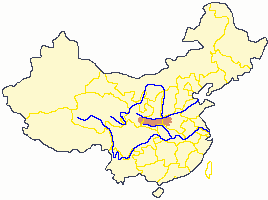Qinling
| Qinling | |
|---|---|
 | |
| Highest point | |
| Peak | Mount Taibai |
| Elevation | 3,767 m (12,359 ft) |
| Coordinates | 33°57′48″N 107°37′05″E / 33.96333°N 107.61806°ECoordinates: 33°57′48″N 107°37′05″E / 33.96333°N 107.61806°E |
| Geography | |
 | |
| Country |
|
| State/Province | Southern Shaanxi Province |
| Qinling | |||||||||
| Traditional Chinese | 秦嶺 | ||||||||
|---|---|---|---|---|---|---|---|---|---|
| Simplified Chinese | 秦岭 | ||||||||
| Literal meaning | Qin Peak(s) | ||||||||
| |||||||||
| Former names | |||||||||
| Southern Mountains | |||||||||
|---|---|---|---|---|---|---|---|---|---|
| Chinese | 南山 | ||||||||
| |||||||||
The Qinling (Chinese: 秦岭) or Qin Mountains, formerly known as the Nanshan ("Southern Mountains") and sometimes called the "Szechuan Alps", are a major east-west mountain range in southern Shaanxi Province, China. The mountains provide a natural boundary between North and South China and support a huge variety of plant and wildlife, some of which is found nowhere else on earth.
To the north is the densely populated Wei River valley, an ancient center of Chinese civilization. To the south is the Han River valley. To the west is the line of mountains along the northern edge of the Tibetan Plateau. To the east are the lower Funiu and Dabie Shan which rise out of the coastal plain.
The northern side of the range is prone to hot weather, however the physical barrier of the mountains mean that the land to the North has a semi-arid climate, with the lack of rich, fertile landscape that can not support a wealth of wildlife.[1] The mountains also acted as a natural defense against nomadic invasions from the North, as only four passes cross the mountains. In the late 1990s a railway tunnel and a spiral was completed, thereby easing travel across the range.[2]
The highest mountain in the range is Mount Taibai at 3,767 meters (12,359 ft), which is about 100 kilometers (62 mi) west of the ancient Chinese capital of Xi'an[3] and is the highest mountain in eastern China. Mount Hua (2,155 meters or 7,070 feet), Mount Li (1,302 meters or 4,272 feet), and Mount Maiji (1,742 meters or 5,715 feet) make up the three other significant peaks in the range.
Environment, flora and fauna
The environment of the Qin Mountains is a deciduous forest ecoregion.[4]
The Qin Mountains form the watershed between the Yellow River basin of northern China, which was historically home to deciduous broadleaf forests, and the Yangzi River basin of southern China, which has milder winters and more rainfall, and was historically home to warm temperate evergreen broadleaf forests.
The low-elevation forests of the foothills are dominated by temperate deciduous trees like oaks (Quercus acutissima, Q. variabilis), elm (Ulmus spp.), common walnut (Juglans regia), maple (Acer spp.), ash (Fraxinus spp.) and Celtis spp. Evergreen species of these low-elevation forests include broadleaf chinquapins (Castanopsis sclerophylla), ring-cupped oaks (Quercus glauca) and conifers like Pinus massoniana.[5]
At the middle elevations, conifers like Pinus armandii are mixed with broadleaf birch (Betula spp.) oak (Quercus spp.) and hornbeam (Carpinus spp.). From 2,600 to 3,000 meters (8,500 to 9,800 ft) elevation, these mid-elevation forests give way to a subalpine forests of fir (Abies fargesii, A. chensiensis), Cunninghamia, and birch (Betula spp.), with rhododendron (Rhododendron fastigiatum) abundant in the understory.[5]
The region is home to a large number of rare plants, of which around 3,000 have so far been documented.[3] Plant and tree species native to the region include Ginkgo, thought to be one of the oldest species of tree in the world, as well as Huashan or Armand pine (Pinus armandii), Huashan shen (Physochlaina infundibularis), Acer miaotaiense and Chinese fir.[6] Timber harvesting reached a peak in the 18th century in the Qinling Mountains.[7]
Home to the Qinling pandas, a sub-species of the giant panda, which are protected in the region with the help of the Changqing and Foping nature reserves,[1] between 250 and 280 giant pandas live in the region, which is estimated to represent around a fifth of the entire wild giant panda population.[3] The mountains are also home to the golden takin, golden pheasant, golden snub-nosed monkey, Temminck's tragopan, crested ibis, golden eagle, blackthroat and clouded leopard.[8]
The Chinese giant salamander, at 1.8 meters (5 ft 11 in) the largest amphibian in the world, is critically endangered as it is collected for food and for use in traditional Chinese medicine. An environmental education programme is being undertaken to encourage sustainable management of wild populations in the Qin Mountains and captive breeding programmes have been set up.[9]
See also
References
- 1 2 World Wildlife Fund, ed. (2001). "Qinling Mountains deciduous forests". WildWorld Ecoregion Profile. National Geographic Society. Archived from the original on 2010-03-08. Retrieved 17 December 2007.
- ↑ "Qinling Breakthroughs". Highbeam Research. Retrieved 2007-12-17.
- 1 2 3 "Qinling Mountains". Bookrags.com. Retrieved 17 December 2007.
- ↑ Olson, D. M, E. Dinerstein; et al. (2001). "Terrestrial Ecoregions of the World: A New Map of Life on Earth". BioScience. 51 (11): 933–938. doi:10.1641/0006-3568(2001)051[0933:TEOTWA]2.0.CO;2. Archived from the original on January 25, 2010.
- 1 2 "Qin Ling Mountains deciduous forests". Terrestrial Ecoregions. World Wildlife Fund. Retrieved June 5, 2011.
- ↑ "Qinling Mountains". Wild Giant Panda. Retrieved 2007-12-17.
- ↑ Forest and Land Management in Imperial China By Nicholas K. Menzies
- ↑ "Qinling giant panda focal project". WWF China. Archived from the original on 2007-10-27. Retrieved 2007-12-17.
- ↑ "Chinese Giant Salamander". ZSL Conservation. Zoological Society of London. Retrieved 2013-07-21.